BY JANET STEINBERG
“Let’s take a powder, to Boston for Chowder, let’s get away
from it all.”
from it all.”
As a teenager, I swooned as Frank Sinatra sang it to
me. As an adult, I delighted as I sailed into Boston Haarbor, the
second-to last port stop on a cruise that transported me 2087 glorious nautical
miles from Montreal to New York City.
me. As an adult, I delighted as I sailed into Boston Haarbor, the
second-to last port stop on a cruise that transported me 2087 glorious nautical
miles from Montreal to New York City.
“Beantown”, as Boston is affectionately dubbed, is much more
than Boston Baked Beans. It is ducks that will splash you into the waters
of the Charles River and swans that will glide you atop the waters of the
Lagoon in Boston’s Public Garden. It is a 3-mile, red-painted Freedom
Trail, and a Holocaust Memorial that towers along that trail.
than Boston Baked Beans. It is ducks that will splash you into the waters
of the Charles River and swans that will glide you atop the waters of the
Lagoon in Boston’s Public Garden. It is a 3-mile, red-painted Freedom
Trail, and a Holocaust Memorial that towers along that trail.
I guarantee you a quacking good time when you board a
Boston Duck Tour. This particular breed of Ducks was hatched during World
War II to meet the demand for an amphibious transport that was half boat and
half truck. The transport, with the code name of DUKW, played a crucial
role in allied operations including the D-Day landing in Normandy.
Boston Duck Tour. This particular breed of Ducks was hatched during World
War II to meet the demand for an amphibious transport that was half boat and
half truck. The transport, with the code name of DUKW, played a crucial
role in allied operations including the D-Day landing in Normandy.
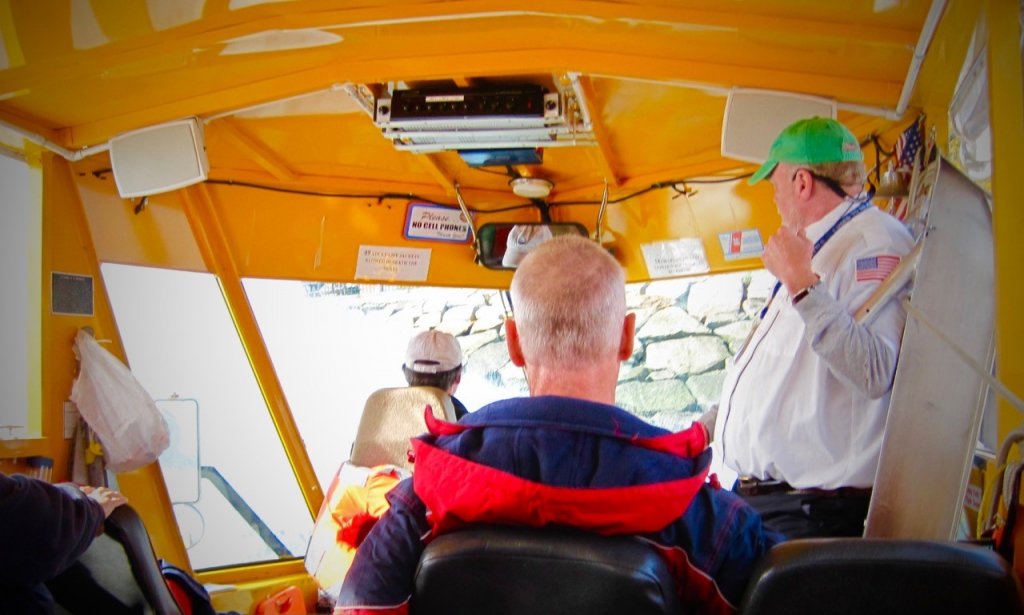 |
| PILOT GUIDES DUCK FROM ROCKY SHORELINE FOR SPLASHDOWN INTO CHARLES RIVER |
Decades later, Boston’s Original Duck Tours take place in
authentic renovated WW II amphibious landing vehicles. Upon
boarding, you will be greeted by a tour ConDUCKtor, who will narrate your
tour. Your land portion of the tour will drive by all the places that
make Boston the birthplace of freedom and a city of firsts. And just when
you think you’ve seen it all, there’s more. It’s time for
“Splashdown” as your ConDUCKtor splashes your DUCK right into the
Charles River for a breathtaking view of the Boston and Cambridge skylines.
Little wonder that the Duck Tour’s slogan is “One big splash and the rest
is history!”
authentic renovated WW II amphibious landing vehicles. Upon
boarding, you will be greeted by a tour ConDUCKtor, who will narrate your
tour. Your land portion of the tour will drive by all the places that
make Boston the birthplace of freedom and a city of firsts. And just when
you think you’ve seen it all, there’s more. It’s time for
“Splashdown” as your ConDUCKtor splashes your DUCK right into the
Charles River for a breathtaking view of the Boston and Cambridge skylines.
Little wonder that the Duck Tour’s slogan is “One big splash and the rest
is history!”
For over 130 years, the Swan Boats have been a part of
the Boston experience. As a welcome sign of spring, they glide along the waters
of the lagoon in the Boston Public Garden,
the first botanical garden in the United States. The Swan Boats, the only
boats of their kind in the world, have been gracefully preening themselves in
Boston’s Public Garden Lagoon since 1877 when Robert Paget developed a
catamaran that housed a foot-propelled paddle wheel. Inspired by the
opera Lohengrin, in which a knight crossed a river in a boat pulled by a swan,
Paget conceived the idea of concealing the boat’s captain with a white swan.
Now a symbol of Boston, the fleet of Swans gives their passengers a chance to
view the 24 acres of glorious greenery in the Public Garden.
the Boston experience. As a welcome sign of spring, they glide along the waters
of the lagoon in the Boston Public Garden,
the first botanical garden in the United States. The Swan Boats, the only
boats of their kind in the world, have been gracefully preening themselves in
Boston’s Public Garden Lagoon since 1877 when Robert Paget developed a
catamaran that housed a foot-propelled paddle wheel. Inspired by the
opera Lohengrin, in which a knight crossed a river in a boat pulled by a swan,
Paget conceived the idea of concealing the boat’s captain with a white swan.
Now a symbol of Boston, the fleet of Swans gives their passengers a chance to
view the 24 acres of glorious greenery in the Public Garden.
And
what would a trip to Boston be without downing a nip at Cheers? When
you step inside the convivial Original Cheers on Beacon Hill (previously known
as the Bull & Finch), you’ll immediately know why everyone knows your name.
Because the bar in the Bull& Finch did not look like the bar on the TV show
the owner Tom Kershaw built a room above the original that is a duplicate of
the one on the show. In 2001, at Faneuil Hall, (rhymes
with Daniel Hall) Kershaw recreated the bar as it appeared on the
set of Cheers
what would a trip to Boston be without downing a nip at Cheers? When
you step inside the convivial Original Cheers on Beacon Hill (previously known
as the Bull & Finch), you’ll immediately know why everyone knows your name.
Because the bar in the Bull& Finch did not look like the bar on the TV show
the owner Tom Kershaw built a room above the original that is a duplicate of
the one on the show. In 2001, at Faneuil Hall, (rhymes
with Daniel Hall) Kershaw recreated the bar as it appeared on the
set of Cheers
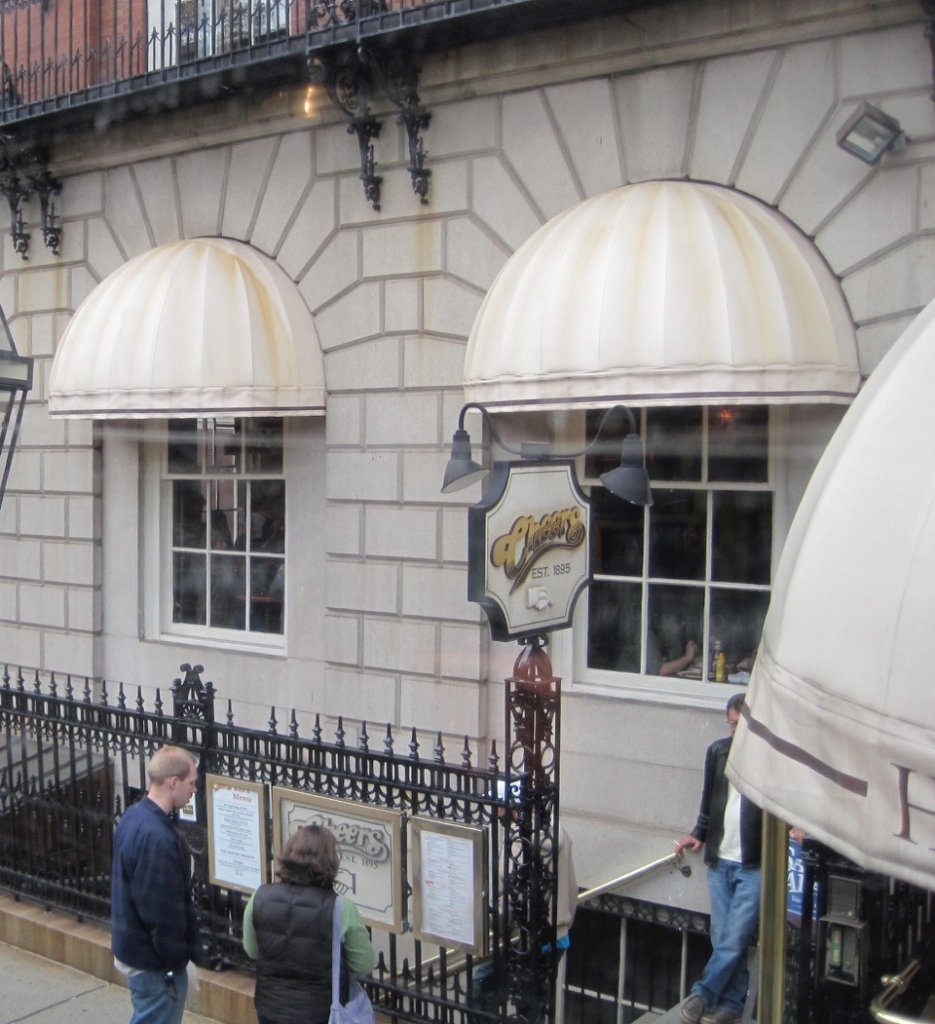 |
|
ORIGINAL
CHEERS ON BEACON HILL |
When
in Boston, you must eat fresh seafood. My stop for Boston’s bounty
from the brine always include Legal Sea Foods and the Union Oyster
House.
in Boston, you must eat fresh seafood. My stop for Boston’s bounty
from the brine always include Legal Sea Foods and the Union Oyster
House.
Legal
Sea Foods is not a fish tale, but a tale of fish 60 years in the making.
It is a tale of a family-owned seafood market that was born in 1950 when George
Berkowitz opened a fish market in the Inman Square neighborhood of Cambridge,
Massachusetts. He opened it adjacent to his father Harry’s grocery store
Legal Cash Market where customers were given “Legal Stamps” (forerunners of
S&H green stamps) with their purchases. It’s here that the “Legal”
name became synonymous with quality and freshness.
Sea Foods is not a fish tale, but a tale of fish 60 years in the making.
It is a tale of a family-owned seafood market that was born in 1950 when George
Berkowitz opened a fish market in the Inman Square neighborhood of Cambridge,
Massachusetts. He opened it adjacent to his father Harry’s grocery store
Legal Cash Market where customers were given “Legal Stamps” (forerunners of
S&H green stamps) with their purchases. It’s here that the “Legal”
name became synonymous with quality and freshness.
In
1968, the family opened its first seafood restaurant, right next to the fish
market. The fish was either broiled or fried, and served on paper plates
at communal picnic tables. Despite the low-key trappings, the food was
second to none and word quickly spread. This early success led to further
expansion and now, six decades later with restaurants along the Eastern
Seaboard, the family philosophy endures: Legal Sea Foods is a fish company in
the restaurant business. Their iconic tagline says it all: “If it isn’t Fresh,
it isn’t Legal”.
1968, the family opened its first seafood restaurant, right next to the fish
market. The fish was either broiled or fried, and served on paper plates
at communal picnic tables. Despite the low-key trappings, the food was
second to none and word quickly spread. This early success led to further
expansion and now, six decades later with restaurants along the Eastern
Seaboard, the family philosophy endures: Legal Sea Foods is a fish company in
the restaurant business. Their iconic tagline says it all: “If it isn’t Fresh,
it isn’t Legal”.
The
Union Oyster House is the oldest restaurant in Boston and the
oldest restaurant in continuous service in the United States.
Union Oyster House is the oldest restaurant in Boston and the
oldest restaurant in continuous service in the United States.
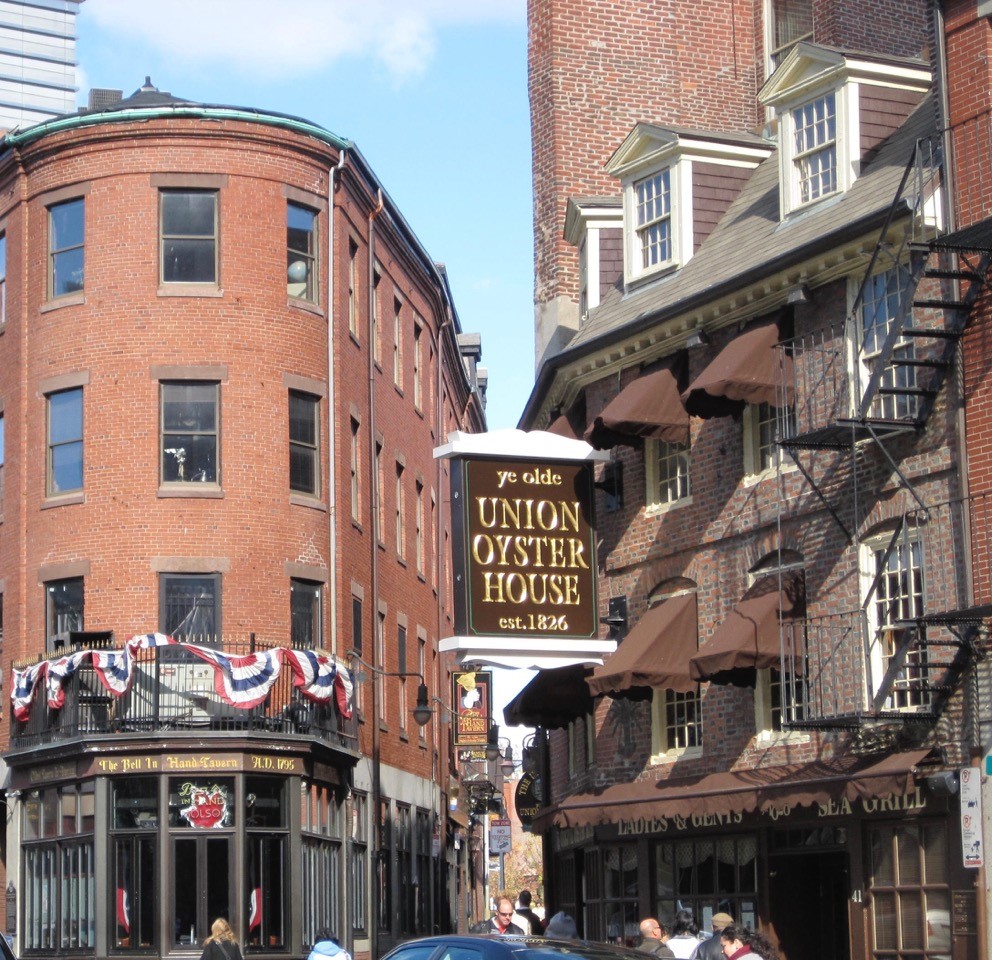 |
| UNION OYSTER HOUSE |
The
doors have always been open to diners since 1826. The Union Oyster
House has been frequented by some very distinguished patrons. President
John F. Kennedy, while still a senator, came in every Sunday to feast in
privacy in the upstairs dining room. He always sat in the same booth to
read his newspapers. “The Kennedy Booth”, booth #18, was
dedicated in his memory in May 1977. You can request booth #18 in advance
and enjoy fresh oysters, cod fishcakes, Boston scrod, authentic Boston baked
beans, and the town’s best Bloody Mary, as you dine in a bit of history.
doors have always been open to diners since 1826. The Union Oyster
House has been frequented by some very distinguished patrons. President
John F. Kennedy, while still a senator, came in every Sunday to feast in
privacy in the upstairs dining room. He always sat in the same booth to
read his newspapers. “The Kennedy Booth”, booth #18, was
dedicated in his memory in May 1977. You can request booth #18 in advance
and enjoy fresh oysters, cod fishcakes, Boston scrod, authentic Boston baked
beans, and the town’s best Bloody Mary, as you dine in a bit of history.
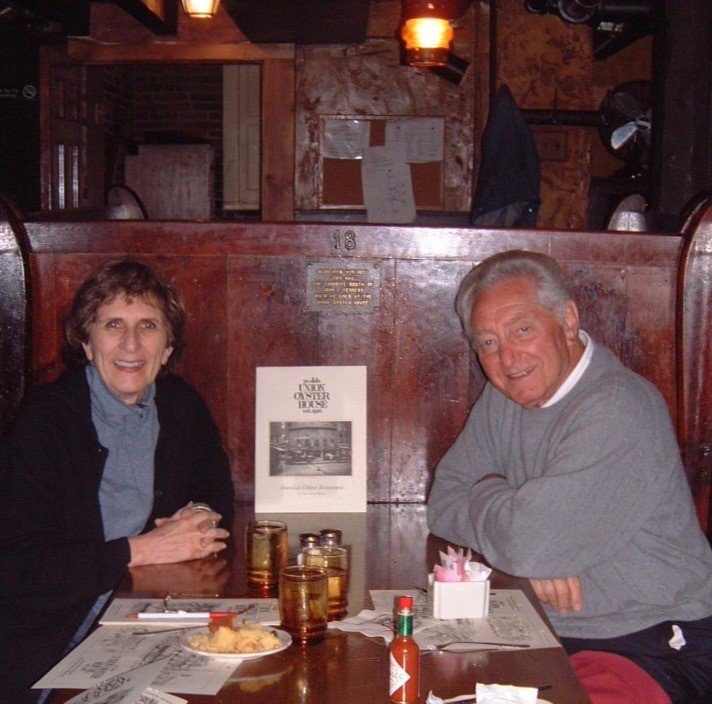 |
| THE KENNEDY BOOTH #18 |
Another
bit of trivia is that the toothpick was first used in the United States at the
Union Oyster House. Enterprising Charles Forster of Maine first imported
the picks from South America. To promote his new business he hired
Harvard boys to dine at the Union Oyster House and ask for toothpicks.
The rest, as they say, is history.
bit of trivia is that the toothpick was first used in the United States at the
Union Oyster House. Enterprising Charles Forster of Maine first imported
the picks from South America. To promote his new business he hired
Harvard boys to dine at the Union Oyster House and ask for toothpicks.
The rest, as they say, is history.
The
Freedom Trail is a 3-mile, red-painted, walking path connecting Boston’s
historic Colonial and Revolutionary sights from the Boston Common to the Bunker
Hill Memorial. The Freedom Trail includes such historic sites as the USS
Constitution (known as “Old Ironsides) and the Old North Church, the
location from which the famous “One if by Land, Two if by Sea”
signal is said to have been sent.
Freedom Trail is a 3-mile, red-painted, walking path connecting Boston’s
historic Colonial and Revolutionary sights from the Boston Common to the Bunker
Hill Memorial. The Freedom Trail includes such historic sites as the USS
Constitution (known as “Old Ironsides) and the Old North Church, the
location from which the famous “One if by Land, Two if by Sea”
signal is said to have been sent.
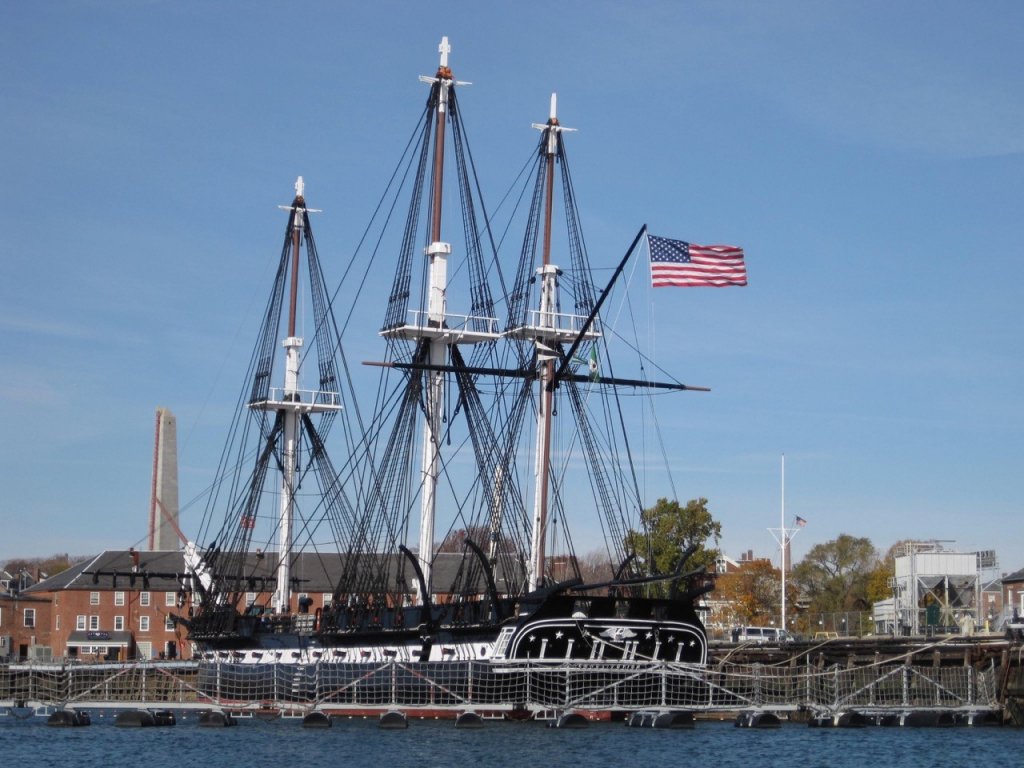 |
|
THE
USS CONSTITUTION aka “OLD IRONSIDES” |
The
New England Holocaust Memorial, located along Boston’s historic Freedom Trail
(in front of the Union Oyster House) was dedicated in October 1995. Built
to foster the memory of one of the great tragedies of our time, the memorial
was conceived by a group of Holocaust survivors who found new lives in the
Boston area. The six luminous, 54-foot tall, glass towers of this
striking memorial, etched with six million numbers in memory of the Jews who
perished in the Holocaust, serve a threefold purpose. They represent the
six million Jews who perished in the Holocaust, they recall the chimneys of the
six main Nazi death camps, and they glow as the candles on a memorial menorah.
Those six glass towers are set on a black granite path, each over a dark
smoldering chamber bearing the name of one of the principal Nazi death camps.
Smoke rises from charred embers at the bottom of these chambers. Elie
Wiesel quoted a great Hasidic master who said: “If you look for
the spark, you will find it in the ashes”.
New England Holocaust Memorial, located along Boston’s historic Freedom Trail
(in front of the Union Oyster House) was dedicated in October 1995. Built
to foster the memory of one of the great tragedies of our time, the memorial
was conceived by a group of Holocaust survivors who found new lives in the
Boston area. The six luminous, 54-foot tall, glass towers of this
striking memorial, etched with six million numbers in memory of the Jews who
perished in the Holocaust, serve a threefold purpose. They represent the
six million Jews who perished in the Holocaust, they recall the chimneys of the
six main Nazi death camps, and they glow as the candles on a memorial menorah.
Those six glass towers are set on a black granite path, each over a dark
smoldering chamber bearing the name of one of the principal Nazi death camps.
Smoke rises from charred embers at the bottom of these chambers. Elie
Wiesel quoted a great Hasidic master who said: “If you look for
the spark, you will find it in the ashes”.
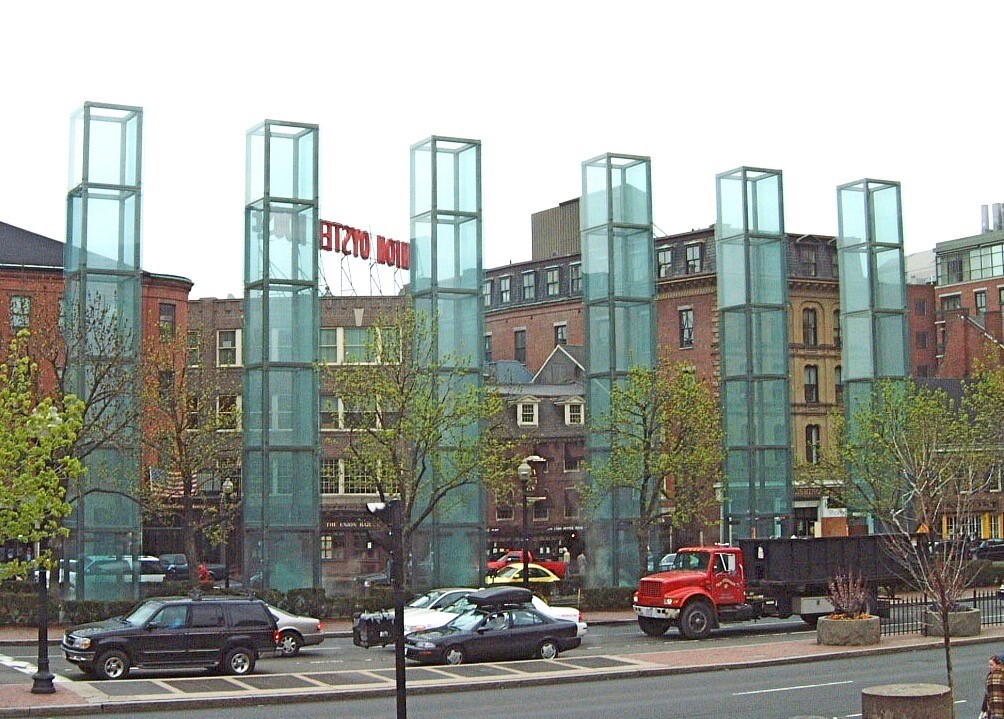 |
| SMOKE RISES FROM THE BOTTOM OF THE GLASS CHAMBERS |
Nobel
Prize winner Elie Wiesel’s own words are also inscribed at the memorial.
They instruct visitors: “Look at these towers, passerby, and try to
imagine what they really mean – what they symbolize – what they evoke.
They evoke an era of incommensurate darkness, an era in history when
civilization lost its humanity and humanity its soul . . .”
Prize winner Elie Wiesel’s own words are also inscribed at the memorial.
They instruct visitors: “Look at these towers, passerby, and try to
imagine what they really mean – what they symbolize – what they evoke.
They evoke an era of incommensurate darkness, an era in history when
civilization lost its humanity and humanity its soul . . .”
“We
must look at these towers of memory and say to ourselves, No one should ever
deprive a human being of his or her right to dignity. No one should ever
deprive anyone of his or her right to be a sovereign human being. No one
should ever speak again about racial superiority… We cannot give evil
another chance.”
must look at these towers of memory and say to ourselves, No one should ever
deprive a human being of his or her right to dignity. No one should ever
deprive anyone of his or her right to be a sovereign human being. No one
should ever speak again about racial superiority… We cannot give evil
another chance.”
JANET
STEINBERG is an International Travel Writer, winner of 41 national Travel
Writing Awards and Travel Consultant with The Travel Authority in Mariemont,
Ohio.
STEINBERG is an International Travel Writer, winner of 41 national Travel
Writing Awards and Travel Consultant with The Travel Authority in Mariemont,
Ohio.
